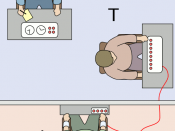conscience vs. Obedience
When individuals relinquish their own autonomy for the benefit of the larger group, they are no longer individual but products of conformity. Obedience to authority can become dangerous when morality and independent thought are stifled to the point that harm is inflicted upon another person. "The Perils of Obedience," by Stanley Milgram reports on his controversial experiment that tested how far individuals would go in obeying orders, even if carrying out those orders caused serious harm to others (Milgram 316-28). In Ian Parker's article, "Obedience," he introduces the concept of situational forces influencing how one would react in a given situation. He points out that people will behave according to where they are and not necessarily because of whom they are. And in "The Stanford Prison Experiment," by Philip K. Zimbardo, he discusses the results of his controversial experiment designed to examine the ability of individuals to resist authoritarian or obedient roles, if the setting and circumstances required those roles (347-58).
Milgram summarizes his experimental findings on obedience to an authority in what some would view as dispassionate detail. Subjects in the experiment are seen suffering over the actions they should take with their moral dilemmas. Obedience is a basic structure of social life and systems of authority are required by all communal living. Social order is dependent on some obedience accepted by the majority (Milgram 371). Yet, as Milgram sought to illustrate in his experiment, obedience to authority becomes dangerous when one obeys commands that are harmful to others. Parker takes this idea and expands upon it by mentioning how people act depending on situational influences
Amanda Ramos Page 2
and not because of any sadistic tendencies ingrained in their psyche in reference to what Professors Lee Ross and Richard E. Nisbett believed. This concept...


